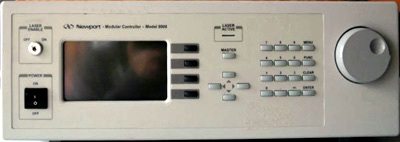
|
|
The Newport 8008 8 channel Modular Mainframe Controller accepts: Combination LDD/TEC Modules; Internal function generator. 2.5 Amps at 6 Volts (15 Watt) highly stable TEC. 200 mA to 2 Amp low noise LDD. Dual Laser Diode Driver (LDD) Module; Two independent outputs per module. 100 to 1,000 mA per channel. Combination LDD/TEC Modules; Internal function generator, (Waveforms: Sine & square wave. Frequency Range: 200 Hz to 2 kHz and 200 Hz to 2 kHz). 2.0 Amps at 4 Volts (8 Watt) highly stable TEC. 200 mA to 2 Amp low noise LDD. Display; Type: LCD graphics display, 240 (W) x 128 (H) pixels. Back Lighting: Green LED. Controls: Brightness and Contrast (contrast optimizes viewing angle). Channel Active: Green LASER ACTIVE LED indicates that at least one Laser Diode output is on and the LCD graphics shows details of active channels. GPIB/IEEE 488.2 and RS-232C Interface
|